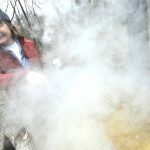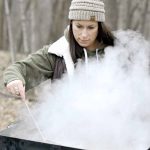Forty to one
That’s the sap-to-syrup ratio for boiling a batch of maple syrup, so patience is a must
-
-Messenger photo by Hans Madsen
Webster County Conservation naturalist Karen Hansen keeps the boiling sap stirred and skimmed Saturday afternoon during the annual Syrup Festival at Camp WaNoKi. This year the event was jointly sponsored by Hamilton and Webster County Conservation.
-
-Messenger photo by Hans Madsen
Breah Ewing, of Fort Dodge, tries her hand at stirring a boiling pot of tree sap that will eventually become syrup Saturday afternoon during the Hamilton/Webster County Conservation Syrup Festival at Camp WaNoKi near Coalville.
-
-Messenger photo by Hans Madsen
Hamilton County Conservation park ranger Keanan Shannon, at right, along with naturalist John Laird, center, talks about the process of tapping trees and making syrup Saturday afternoon during the annual Syrup Festival at Camp WaNoKi near Coalville. The event is jointly sponsored by Hamilton and Webster County Conservation.
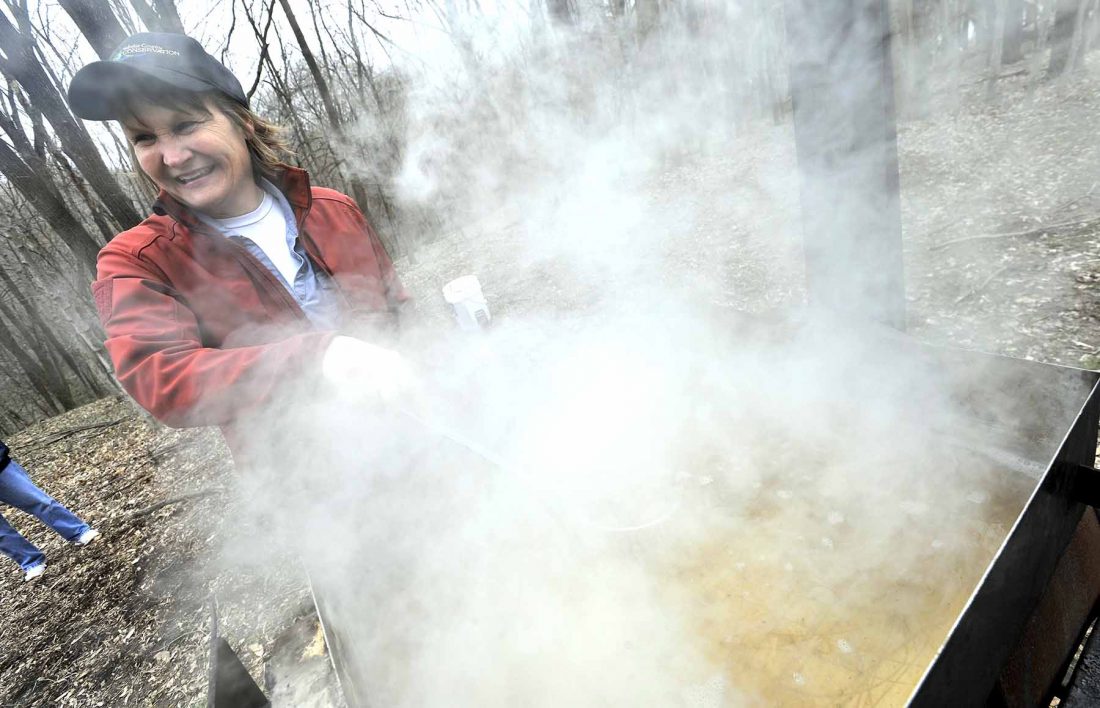
-Messenger photo by Hans Madsen
Webster County Conservation naturalist Karen Hansen keeps the boiling sap stirred and skimmed Saturday afternoon during the annual Syrup Festival at Camp WaNoKi. This year the event was jointly sponsored by Hamilton and Webster County Conservation.
CAMP WANOKI — Webster County Conservation naturalist Karen Hansen had her work cut out for her Saturday during the annual Maple Syrup Festival at Camp WaNoKi near Coalville.
It was her job to keep the fire going, add more tree sap, skim the various pieces of debris that found themselves floating on the roiling liquid and, of course, answer questions for visitors.
It takes about 40 gallons of maple sap to make one gallon of syrup.
“It’s a long day of cooking sap,” she said. “As it boils down, I add more sap, then add more sap, then add more sap and then add more sap.”
It’s a good job for a chilly spring day.
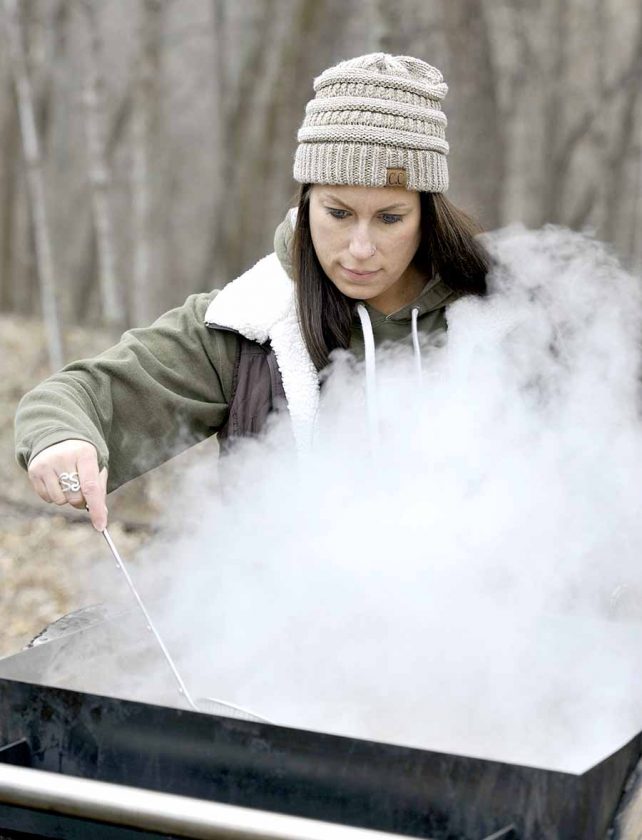
-Messenger photo by Hans Madsen
Breah Ewing, of Fort Dodge, tries her hand at stirring a boiling pot of tree sap that will eventually become syrup Saturday afternoon during the Hamilton/Webster County Conservation Syrup Festival at Camp WaNoKi near Coalville.
“If you want to be out in the woods for a long time this is the thing to do,” she said.
Of course, someone who’s doing so is probably going to enjoy that time outside.
“It’s a great cure for cabin fever,” she added.
The Maple Syrup Festival is jointly sponsored by both Hamilton and Webster County Conservation. The two agencies share their resources during events which benefit residents of both counties.
Hamilton County Conservation naturalist John Laird and park ranger Keanan Shannon demonstrated the tree tapping techniques required to harvest the sap.
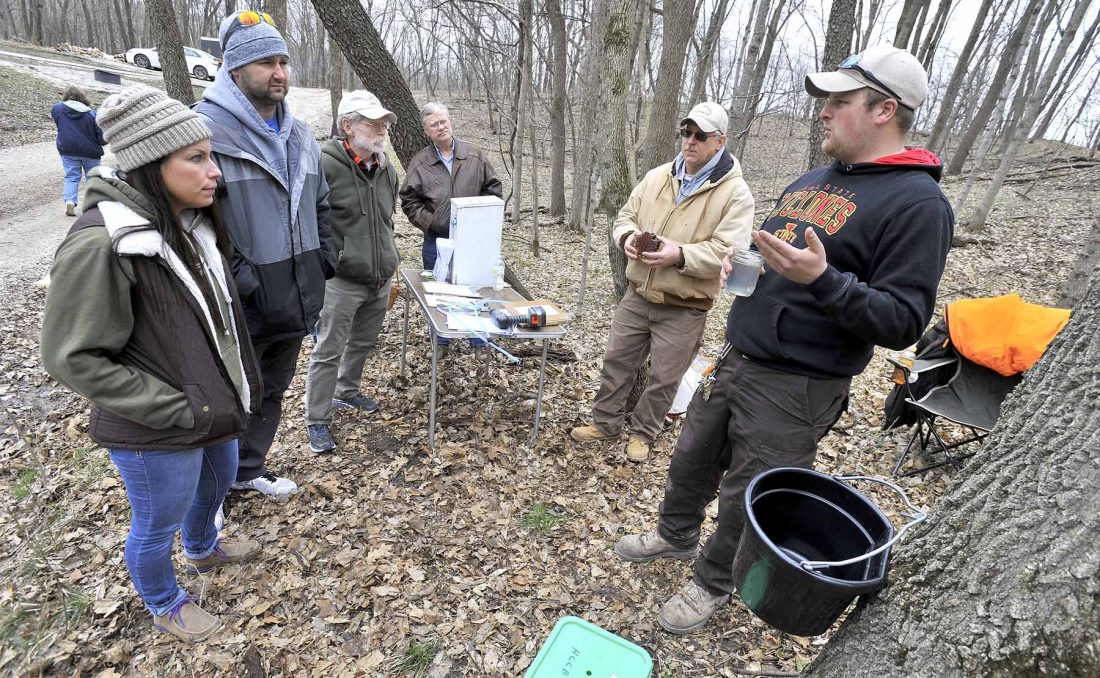
-Messenger photo by Hans Madsen
Hamilton County Conservation park ranger Keanan Shannon, at right, along with naturalist John Laird, center, talks about the process of tapping trees and making syrup Saturday afternoon during the annual Syrup Festival at Camp WaNoKi near Coalville. The event is jointly sponsored by Hamilton and Webster County Conservation.
Shannon said that the tree sap usually runs for about a month and runs best during ideal conditions.
“If it’s below freezing at night and about 40 during the day,” he said.
The sap is taken from the outer layer of the tree just under the bark.
“It goes to the leaves for photosynthesis,” Laird said. “It’s stored in the roots during the winter as starch.”
The art of tree tapping and making syrup was taught to early settlers by the Native Americans. They would boil the sap down until it crystallized into a sugar which made it portable. Early settlers did the same for the same reason. It was in some cases the only available sweetener during the early history of the U.S.
The trees at WaNoKi each hold a bucket to catch the sap. Larger commercial operations use a system of tubes that lead into a central collection tank.
A tree can produce up to a gallon a day.
“It varies,” Laird said. “There’s a lot of variables such as tree size and temperatures.”
The tapping season will end soon.
“As soon as the trees start to bud, you’re done,” Shannon said.
Howard Jensen, of Fort Dodge, stopped by for a visit. He helped start the event and learned a valuable lesson the first time he tried making syrup — do it outside — 40 gallons of sap creates a lot of steam.
“The first time I did it indoors,” he said. “The wallpaper started to sag. I was told, ‘If you’re going to do this again, you better find a way to do it outdoors.”
So how does it taste?
Samples were available, and at least one person prefers the genuine maple syrup to anything else.
“My grandson says he won’t eat anything but ‘pa syrup,'” Jensen said.
That’s a sweet endorsement.

